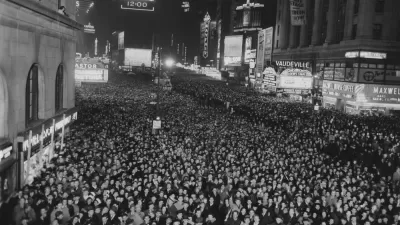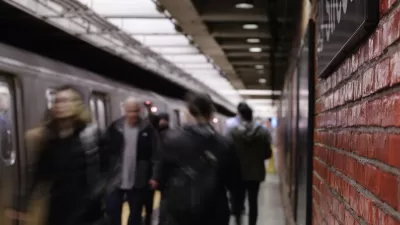As sky-high real estate prices force many lower-income New Yorkers to the periphery, they're paying an additional price in lengthy transit commutes. Meanwhile, real estate interests that benefit from transit investment bear few of its costs.

While negative stories on New York's transit system often focus on dramatic incidents, Jim Dwyer writes, the real problem is less picturesque. For many lower-income users, "The city's transit system controls everyday life [...] so insistently and so routinely that no one has thought to declare the situation a state of emergency."
Dwyer cites a 2013 study by the Pratt Center for Community Development and the Rockefeller Foundation indicating that "758,000 New York City residents now travel more than an hour each way to work, most of them to jobs that pay less than $35,000 per year." In addition, "Black New Yorkers' trips to work are 25 percent longer than whites, and Hispanics, 12 percent longer than whites, other research by the Pratt Center found."
Dwyer also points to the fact that despite New York transit's long-standing history of boosting nearby real estate, "none of the current proposals by the mayor or the governor for funding it touch on property values. That means the system captures none of the boom created by the new Second Avenue subway line on the Upper East Side of Manhattan."
FULL STORY: Pushing New Yorkers Beyond the End of the Line

Planetizen Federal Action Tracker
A weekly monitor of how Trump’s orders and actions are impacting planners and planning in America.

Congressman Proposes Bill to Rename DC Metro “Trump Train”
The Make Autorail Great Again Act would withhold federal funding to the system until the Washington Metropolitan Area Transit Authority (WMATA), rebrands as the Washington Metropolitan Authority for Greater Access (WMAGA).

The Simple Legislative Tool Transforming Vacant Downtowns
In California, Michigan and Georgia, an easy win is bringing dollars — and delight — back to city centers.

The States Losing Rural Delivery Rooms at an Alarming Pace
In some states, as few as 9% of rural hospitals still deliver babies. As a result, rising pre-term births, no adequate pre-term care and harrowing close calls are a growing reality.

The Small South Asian Republic Going all in on EVs
Thanks to one simple policy change less than five years ago, 65% of new cars in this Himalayan country are now electric.

DC Backpedals on Bike Lane Protection, Swaps Barriers for Paint
Citing aesthetic concerns, the city is removing the concrete barriers and flexposts that once separated Arizona Avenue cyclists from motor vehicles.
Urban Design for Planners 1: Software Tools
This six-course series explores essential urban design concepts using open source software and equips planners with the tools they need to participate fully in the urban design process.
Planning for Universal Design
Learn the tools for implementing Universal Design in planning regulations.
Smith Gee Studio
City of Charlotte
City of Camden Redevelopment Agency
City of Astoria
Transportation Research & Education Center (TREC) at Portland State University
US High Speed Rail Association
City of Camden Redevelopment Agency
Municipality of Princeton (NJ)





























